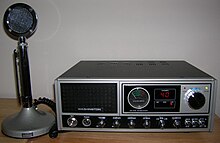
Back Гражданска радиовръзка Bulgarian Banda ciutadana Catalan Citizen Band Czech CB-radio Danish CB-Funk German Banda ciudadana Spanish رادیوی باند شهروندان Persian LA-radiopuhelin Finnish Citizen-band French Banda na saoránach Irish



Citizens band radio (CB radio) is a land mobile radio system, a system allowing short-distance one-to-many bidirectional voice communication among individuals, using two-way radios operating near 27 MHz (or the 11-m wavelength) in the high frequency or shortwave band. Citizens band is distinct from other personal radio service allocations such as FRS, GMRS, MURS, UHF CB and the Amateur Radio Service ("ham" radio). In many countries, CB operation does not require a license and may be used for business or personal communications.
Like many other land mobile radio services, multiple radios in a local area share a single frequency channel, but only one can transmit at a time. The radio is normally in receive mode to receive transmissions of other radios on the channel; when users want to communicate they press a "push to talk" button on their radio, which turns on their transmitter. Users on a channel must take turns transmitting. In the US and Canada, and in the EU and the UK, transmitter power is limited to 4 watts when using AM and FM and 12 W PEP when using SSB. Illegal amplifiers to increase range are common.
CB radios using an omni-directional vertical antenna typically have a range of about 5 km to 30 km depending on terrain, for line of sight communication; however, various radio propagation conditions may intermittently allow communication over much greater distances. Base stations however may be connected to a directional Yagi–Uda antenna commonly called a Beam or a Yagi. Yagi–Uda antennae focus the transmitted signal in a particular direction while at the same time minimising the reception of signals coming from the rear of the antenna. Using a Yagi-Uda antenna can increase range substantially because the transmitted signal will travel farther while the rejection of received signals coming from the rear will simultaneously reduce unwanted incoming signals. The pro of increased range on one direction has the cons of losing range in any other, so to use a Yagi-Uda antenna one typically needs to also use a rotator for the antenna mast to turn the antenna to the desired direction much as Television antennas are sometimes turned to maximise TV reception.
Multiple countries have created similar radio services, with varying technical standards and requirements for licensing. While they may be known by other names, such as the General Radio Service in Canada,[1] they often use similar frequencies (26–28 MHz) and have similar uses, and similar technical standards. Although licenses may be required, eligibility is generally simple. Some countries also have personal radio services in the UHF band, such as the European PMR446 and the Australian UHF CB.
- ^ Telecommunications, Government of Canada, Innovation, Science and Economic Development Canada, Office of the Deputy Minister, Spectrum, Information Technologies and (27 August 2002). "RIC-18 — General Radio Service (GRS)". strategis.ic.gc.ca. Archived from the original on 12 January 2008. Retrieved 8 May 2018.
{{cite web}}: CS1 maint: multiple names: authors list (link)